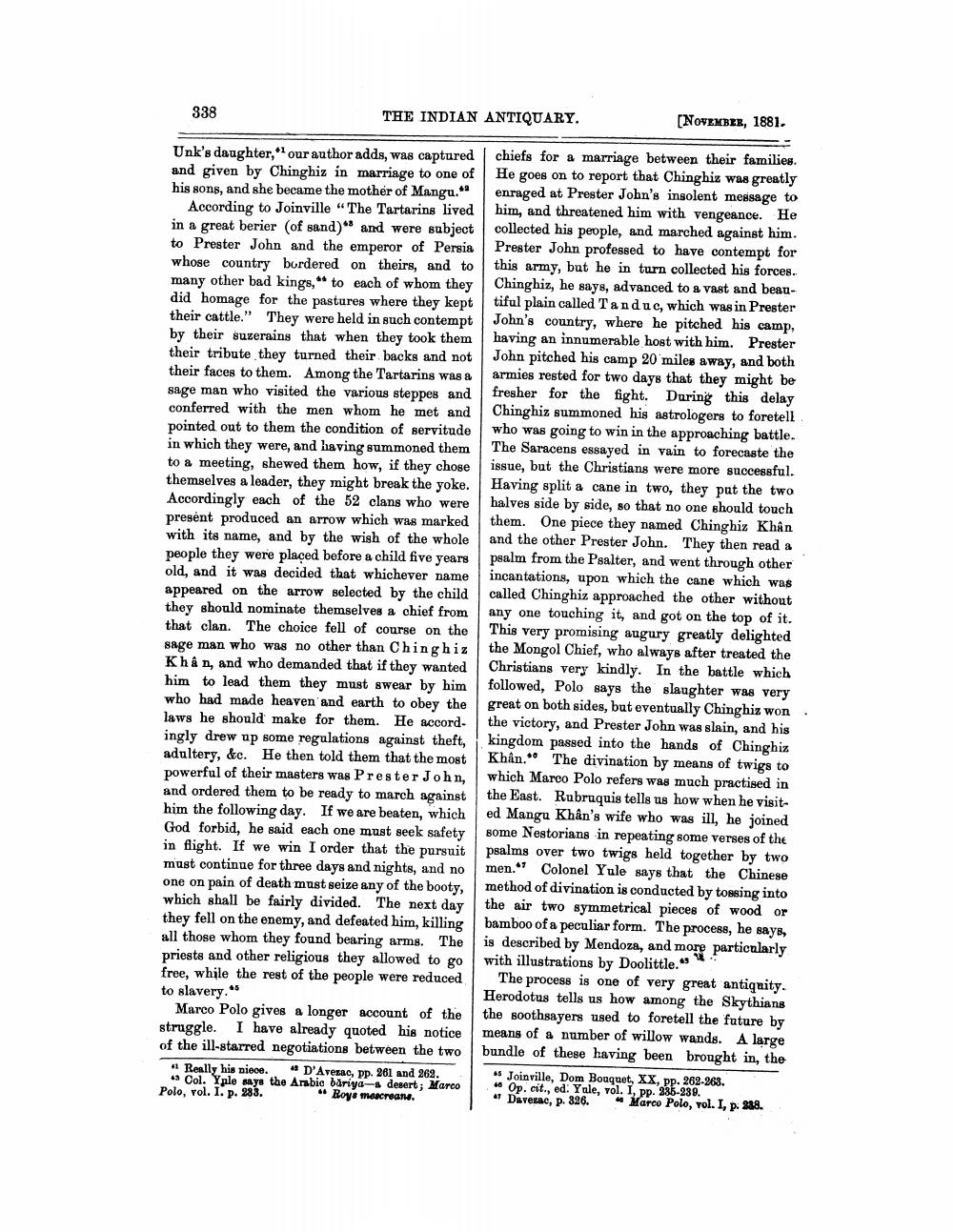________________
338
THE INDIAN ANTIQUARY.
[NOVEMBER, 1881.
Unk's daughter,"our author adds, was captured and given by Chinghiz in marriage to one of his sons, and she became the mother of Mangu."
According to Joinville "The Tartarins lived in a great berier (of sand)" and were subject to Prester John and the emperor of Persia whose country bordered on theirs, and to many other bad kings, *to each of whom they did homage for the pastures where they kept their cattle." They were held in such contempt by their suzerains that when they took them their tribute they turned their backs and not their faces to them. Among the Tartarins was a
man who visited the various steppes and conferred with the men whom he met and pointed out to them the condition of servitude in which they were, and having summoned them to a meeting, shewed them how, if they chose themselves a leader, they might break the yoke. Accordingly each of the 52 clans who were present produced an arrow which was marked with its name, and by the wish of the whole people they were placed before a child five years old, and it was decided that whichever name appeared on the arrow selected by the child they should nominate themselves a chief from that clan. The choice fell of course on the sage man who was no other than Chinghiz Khân, and who demanded that if they wanted him to lead them they must swear by him who had made heaven and earth to obey the laws he should make for them. He accord. ingly drew up some regulations against theft, adultery, &c. He then told them that the most powerful of their masters was Prester John, and ordered them to be ready to march against him the following day. If we are beaten, which God forbid, he said each one must seek safety in flight. If we win I order that the pursuit must continue for three days and nights, and no one on pain of death must seize any of the booty, which shall be fairly divided. The next day they fell on the enemy, and defeated him, killing all those whom they found bearing arms. The priests and other religious they allowed to go free, while the rest of the people were reduced to slavery."
Marco Polo gives a longer account of the struggle. I have already quoted his notice of the ill-starred negotiations between the two #1 Really his piece. « D'Avenac, pp. 261 and 262. Col. Yple says the Arabie bariya- desert; Marco
923 Polo, vol. I. p. 283.
Boya mecrea.
chiefs for a marriage between their families. He goes on to report that Chinghiz was greatly enraged at Prester John's insolent message to him, and threatened him with vengeance. He collected his people, and marched against him. Prester John professed to have contempt for this army, but he in turn collected his forces. Chinghiz, he says, advanced to a vast and beautiful plain called Tanduc, which was in Prester John's country, where he pitched his camp, having an innumerable host with him. Prester John pitched his camp 20 miles away, and both armies rested for two days that they might be fresher for the fight. During this delay Chinghiz summoned his astrologers to foretell who was going to win in the approaching battle. The Saracens essayed in vain to forecaste the issue, but the Christians were more successful. Having split a cane in two, they put the two halves side by side, so that no one should touch them. One piece they named Chinghiz Khân and the other Prester John. They then read a psalm from the Psalter, and went through other incantations, upon which the cane which was called Chinghiz approached the other without any one touching it, and got on the top of it. This very promising augury greatly delighted the Mongol Chief, who always after treated the Christiang very kindly. In the battle which followed, Polo says the slaughter was very great on both sides, but eventually Chinghiz won. the victory, and Prester John was slain, and his
kingdom passed into the hands of Chinghix | Khân." The divination by means of twigs to which Marco Polo refers was much practised in the East. Rubruquis tells us how when he visited Mangu Khân's wife who was ill, he joined some Nestorians in repeating some verses of the psalms over two twigs held together by two men." Colonel Yule says that the Chinese method of divination is conducted by tossing into the air two symmetrical pieces of wood or bamboo of a peculiar form. The process, he says, is described by Mendoza, and more particularly with illustrations by Doolittle."
The process is one of very great antiquity. Herodotus tells us how among the Skythians the soothsayers used to foretell the future by means of a number of willow wands. A large bundle of these having been brought in, the
* Joinville, Dom Bouquet, XX, pp. 262-263. * Op. cit., ed: Yale, vol. I, pp. 335-239. " Davetac, p. 326. Marco Polo, vol. I, p. 288.




